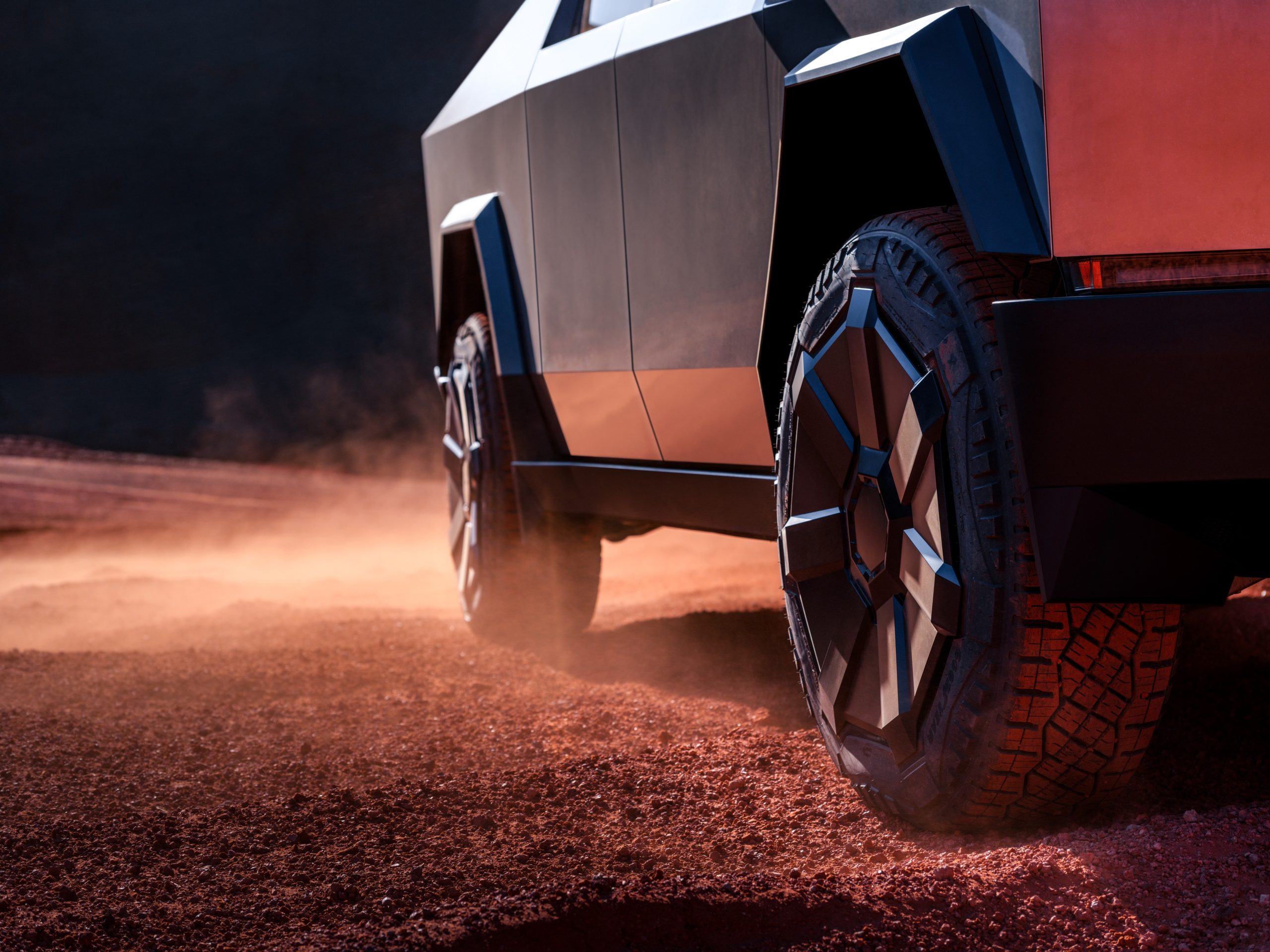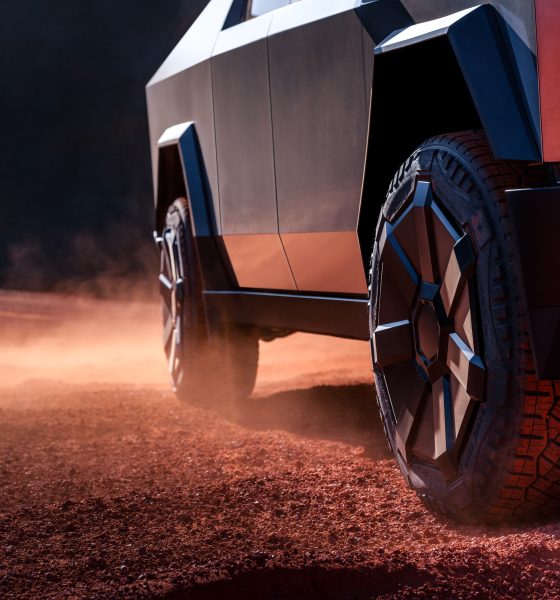In the past few days, many media sources have claimed that Tesla Cybertruck owners have been starting to see their stainless steel electric vehicles (EVs) begin to rust, though some suggest that it may not be as much of a problem as has been reported.
Justin Demaree, host of the YouTube channel Bearded Tesla Guy, shared a video on Friday addressing the claims of rust on the Cybertruck’s exterior, along with showing some of the best ways to get any oxidation off of the stainless steel pickup. The oxidation, which is super tiny and difficult to even see in the video, comes in small orange specks, most likely being “rust dust” or “rail dust.” Fortunately, it’s only surface contamination and can easily be cleaned with the right solution.
This can happen anywhere in a factory where metal polishing or grinding happens, such as in factories or near railroad tracks, as the grinding of metals causes microparticles to be dispersed.
The video was also shared on X by Tesla’s lead Cybertruck engineer, Wes Morrill, who points out that Bar Keeper’s Friend is a great solution for loosening the surface oxidation, letting the user wipe it right off. He also calls Justin’s video “good myth busting,” adding in a follow-up comment that Cybertruck owners can literally buff the metal to get any surface marks out, even if they’re deeply embedded in the stainless steel.
Good myth busting. Stainless is reactive and free iron that sits on it will rust. It's surface contamination only and can be cleaned off easily. Bar Keeper's Friend used here works well, citrisurf77 can also loosen the deposit and simply wipe it off. If anything stubborn use a… https://t.co/HD3Xeo0inH
— Wes (@wmorrill3) February 16, 2024
CEO Elon Musk responded to Morrill’s post about the issue, simply saying “yeah,” to affirm Justin and Wes’s claims.
“The benefit of Cybertruck is you can remove a scratch by buffing the metal even if it’s super deep, with enough effort you can remove it and have a factory finish,” Morrill added later in the thread. “Typical clear coat is at most 50 microns thick so a scratch deeper than that cannot be fixed without repainting.”
The engineer also shared a photo of another dirty car in a parking lot he was in, showing that, if you look closely, the vehicle included many of the same small oxidation spots that are being reported to be exclusive to the Cybertruck because of its steel.
You can watch the full Bearded Tesla video below, with Justin detailing the Cybertruck oxidation issue and showing the use of Bar Keeper’s Friend and two other glass cleaners to wipe away rust dust and fingerprints.
Similarly, Tesla Design Chief Franz von Holzhausen recently talked about scratch removal on the Cybertruck on a podcast last January, along with how long it took the automaker to develop the durable stainless steel and its finish. Those who want to remove scratches or other surface issues on the exterior, as Morrill recently echoed, can simply buff it out.
“We spent a lot of time developing a finish that can be — the stainless is incredibly hard — so if in the event that there is a scratch, we do have a process that you could yourself basically buff it and remove the scratch as well and return to the basic finish that’s on the stainless,” the design executive said during the Ride the Lightning podcast.
“It’s a different process. It’s not the same as the brush finish on a refrigerator or a DeLorean or something. There is an intentional finish that we apply to it. And it is able to be cured or fixed, or in the event that you know it’s going to be something pretty intense that does actually scratch the surface.”
Tesla will help you get your Cybertruck faster, but at a cost
Have you had experiences with oxidation or “rust dust” on your Cybertruck? Let me know at zach@teslarati.com, find me on X at @zacharyvisconti, or send us news tips at tips@teslarati.com.

News
Tesla FSD fleet is nearing 7 billion total miles, including 2.5 billion city miles
As can be seen on Tesla’s official FSD webpage, vehicles equipped with the system have now navigated over 6.99 billion miles.

Tesla’s Full Self-Driving (Supervised) fleet is closing in on almost 7 billion total miles driven, as per data posted by the company on its official FSD webpage.
These figures hint at the massive scale of data fueling Tesla’s rapid FSD improvements, which have been quite notable as of late.
FSD mileage milestones
As can be seen on Tesla’s official FSD webpage, vehicles equipped with the system have now navigated over 6.99 billion miles. Tesla owner and avid FSD tester Whole Mars Catalog also shared a screenshot indicating that from the nearly 7 billion miles traveled by the FSD fleet, more than 2.5 billion miles were driven inside cities.
City miles are particularly valuable for complex urban scenarios like unprotected turns, pedestrian interactions, and traffic lights. This is also the difference-maker for FSD, as only complex solutions, such as Waymo’s self-driving taxis, operate similarly on inner-city streets. And even then, incidents such as the San Francisco blackouts have proven challenging for sensor-rich vehicles like Waymos.
Tesla’s data edge
Tesla has a number of advantages in the autonomous vehicle sector, one of which is the size of its fleet and the number of vehicles training FSD on real-world roads. Tesla’s nearly 7 billion FSD miles then allow the company to roll out updates that make its vehicles behave like they are being driven by experienced drivers, even if they are operating on their own.
So notable are Tesla’s improvements to FSD that NVIDIA Director of Robotics Jim Fan, after experiencing FSD v14, noted that the system is the first AI that passes what he described as a “Physical Turing Test.”
“Despite knowing exactly how robot learning works, I still find it magical watching the steering wheel turn by itself. First it feels surreal, next it becomes routine. Then, like the smartphone, taking it away actively hurts. This is how humanity gets rewired and glued to god-like technologies,” Fan wrote in a post on X.
News
Tesla starts showing how FSD will change lives in Europe
Local officials tested the system on narrow country roads and were impressed by FSD’s smooth, human-like driving, with some calling the service a game-changer for everyday life in areas that are far from urban centers.

Tesla has launched Europe’s first public shuttle service using Full Self-Driving (Supervised) in the rural Eifelkreis Bitburg-Prüm region of Germany, demonstrating how the technology can restore independence and mobility for people who struggle with limited transport options.
Local officials tested the system on narrow country roads and were impressed by FSD’s smooth, human-like driving, with some calling the service a game-changer for everyday life in areas that are far from urban centers.
Officials see real impact on rural residents
Arzfeld Mayor Johannes Kuhl and District Administrator Andreas Kruppert personally tested the Tesla shuttle service. This allowed them to see just how well FSD navigated winding lanes and rural roads confidently. Kruppert said, “Autonomous driving sounds like science fiction to many, but we simply see here that it works totally well in rural regions too.” Kuhl, for his part, also noted that FSD “feels like a very experienced driver.”
The pilot complements the area’s “Citizen Bus” program, which provides on-demand rides for elderly residents who can no longer drive themselves. Tesla Europe shared a video of a demonstration of the service, highlighting how FSD gives people their freedom back, even in places where public transport is not as prevalent.
What the Ministry for Economic Affairs and Transport says
Rhineland-Palatinate’s Minister Daniela Schmitt supported the project, praising the collaboration that made this “first of its kind in Europe” possible. As per the ministry, the rural rollout for the service shows FSD’s potential beyond major cities, and it delivers tangible benefits like grocery runs, doctor visits, and social connections for isolated residents.
“Reliable and flexible mobility is especially vital in rural areas. With the launch of a shuttle service using self-driving vehicles (FSD supervised) by Tesla in the Eifelkreis Bitburg-Prüm, an innovative pilot project is now getting underway that complements local community bus services. It is the first project of its kind in Europe.
“The result is a real gain for rural mobility: greater accessibility, more flexibility and tangible benefits for everyday life. A strong signal for innovation, cooperation and future-oriented mobility beyond urban centers,” the ministry wrote in a LinkedIn post.
News
Tesla China quietly posts Robotaxi-related job listing
Tesla China is currently seeking a Low Voltage Electrical Engineer to work on circuit board design for the company’s autonomous vehicles.

Tesla has posted a new job listing in Shanghai explicitly tied to its Robotaxi program, fueling speculation that the company is preparing to launch its dedicated autonomous ride-hailing service in China.
As noted in the listing, Tesla China is currently seeking a Low Voltage Electrical Engineer to work on circuit board design for the company’s autonomous vehicles.
Robotaxi-specific role
The listing, which was shared on social media platform X by industry watcher @tslaming, suggested that Tesla China is looking to fill the role urgently. The job listing itself specifically mentions that the person hired for the role will be working on the Low Voltage Hardware team, which would design the circuit boards that would serve as the nervous system of the Robotaxi.
Key tasks for the role, as indicated in the job listing, include collaboration with PCB layout, firmware, mechanical, program management, and validation teams, among other responsibilities. The role is based in Shanghai.
China Robotaxi launch
China represents a massive potential market for robotaxis, with its dense urban centers and supportive policies in select cities. Tesla has limited permission to roll out FSD in the country, though despite this, its vehicles have been hailed as among the best in the market when it comes to autonomous features. So far, at least, it appears that China supports Tesla’s FSD and Robotaxi rollout.
This was hinted at in November, when Tesla brought the Cybercab to the 8th China International Import Expo (CIIE) in Shanghai, marking the first time that the autonomous two-seater was brought to the Asia-Pacific region. The vehicle, despite not having a release date in China, received a significant amount of interest among the event’s attendees.










